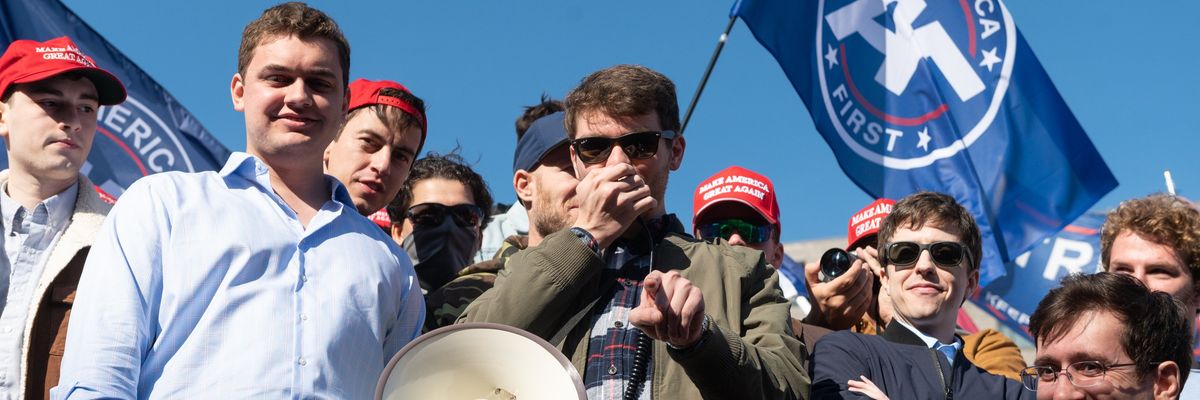Through the late 2010s, pundits hailed Gen Z as America’s most progressive young cohort. Yet, the truth is more complicated: While many young voters voice support for climate action, racial justice, and reproductive rights, their overall partisan tilt is far less lopsided than early headlines implied. Support for Democrats among under-30 voters has softened since 2020, and young men in particular are drifting rightward on issues like gender equality and LGBTQ+ rights.
That gap between reputation and reality is, in part, due to a rising cadre of young conservatives who are more radical, more visible, and better organized than their progressive peers. From Nick Fuentes to Laura Loomer to the late Charlie Kirk, the figures shaping the far-right agenda have been startlingly young. Why, then, are some of the movement’s most prominent figures in their late 20s and early 30s? How did a political current once defined by veteran politicians and talk-radio personalities come to be led by live-streamers and college-circuit activists?
Consider Fuentes. Only 28, yet he commands a national audience of more than 700,000 followers. He has a dedicated fanbase, connections to GOP congressmen, and once had a private dinner with US President Donald Trump. And Fuentes is not an outlier. From political candidates to campus organizers, the far-right’s most prominent figures are getting younger—and more extreme.
The explanation lies in the internet’s ecosystem. Figures like Mike Cernovich and Jack Posobiec were among the first to show how provocation and relentless online promotion could transform fringe ideas into mass influence. In the years since, news has gone largely digital, with about 86% of Americans getting at least some of their news on phones or computers. The overwhelming bulk of political information now flows through a dense lattice of live-streams, podcasts, and Discord servers, all spaces young people navigate with native ease.
For ambitious young people, each viral provocation can bring a surge of followers and donations, turning radicalism into a fast track to high-profile visibility.
In this landscape, digital platforms have dismantled traditional barriers to political power. Two decades ago, a young ideologue needed gatekeepers—local radio, party donors, sympathetic editors—to build a following. Today, a ring light and an algorithm are enough. YouTube, Twitch, TikTok, and X provide inexpensive infrastructure and frictionless amplification, allowing individuals to raise money, mobilize supporters, and establish a brand long before institutions can react.
Why is this dynamic propelling the far-right in particular? Without much formal representation in elected office, these ideas circulate almost entirely online, where scarcity makes them more alluring. And algorithms reward outrage, propelling the sharpest sound bites and most incendiary claims to the top of every feed. For ambitious young people, each viral provocation can bring a surge of followers and donations, turning radicalism into a fast track to high-profile visibility.
Conservative legacy media compounds the effect. Figures who achieve algorithmic virality are quickly booked on cable programs and high-profile podcasts, which confer legitimacy and feed the next surge of online attention. The result is a self-reinforcing loop: Digital notoriety leads to mainstream exposure, which drives further radical content.
The American left lacks a parallel generation of online, movement-building leaders. Progressive lawmakers such as Sen. Bernie Sanders (I-Vt.) and Rep. Alexandria Ocasio-Cortez (D-N.Y.) have national profiles, but their influence depends on elected office and formal party structures rather than on a grassroots, youth-led network. Yes, young progressives such as Dean Withers and Matt Bernstein have built impressive reputations as digital advocates for progressive causes. But they operate largely as individual voices, not as architects of a nationwide, highly-branded youth movement comparable to Kirk's Turning Point USA or Fuentes' America First movement. Comparable grassroots movements on the left, like the emerging 50501, lack visible leaders capable of unifying and sustaining a broad, youth-driven base.
This distinction matters. Without a cohesive, youth-led movement, progressives struggle to match the visibility and narrative power of their far-right counterparts. Every far-right provocation arrives with a spokesperson and a polished national platform, while the left relies on a handful of elected officials and scattered digital voices. The absence of equally prominent, institutionally supported young progressives cedes narrative ground, and gives rising alt-right leaders disproportionate space to break out online.
Addressing this imbalance will not turn on deplatforming extremist voices alone; the internet’s architecture makes that a game of whac-a-mole. Nor will it come solely from established progressive leaders. It requires cultivating and sustaining a cohort of young progressives who can operate effectively online and build movements without succumbing to social media's darkest ideologies. It also requires a cultural shift on the left: valuing charismatic leadership as a complement—not a substitute—for collective action.
Gen Z was supposed to guarantee a progressive future. Instead, many of its most visible political entrepreneurs are on the far-right. Unless progressives move beyond supporting individual creators and intentionally develop their own social movements, the loudest young voices shaping America’s political future will continue to belong to its most far-right fringes.



